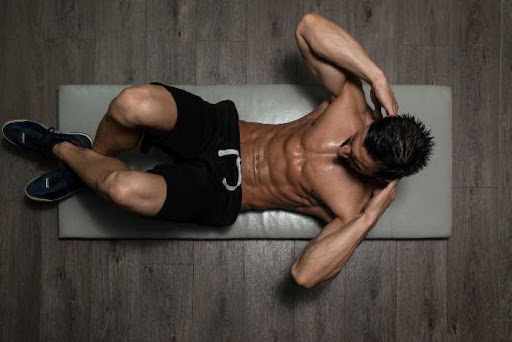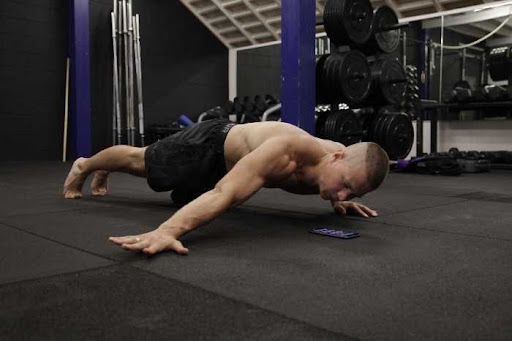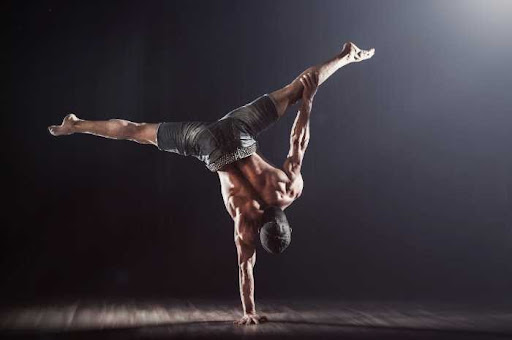Join the tribe of Movement & Calisthenics Athlete – people just like you that are working with their own body weight to get strength, lose fat build muscle, recover from injuries and live their best lives!
🤔 How long should I rest in between each set and exercise? This is a question that many athletes in calisthenics or weight training ask themselves.
What does science say?🧐 The answer may surprise you, and it’s not as straightforward as you might have thought it would have.
In this blog post, we will explore how resting for different lengths of time affects your strength gains and muscle growth. We’ll also provide you with some helpful tips to make the most of your rests between sets.
Factors for determining the best rest period
The fitness world is filled with contradictory information on how long you should rest between sets. ☝️ Some sources say that you need to rest for 30-45 seconds, while others say it’s more important to keep your heart rate up and keep moving continuously.
What is the answer?
How do muscles💪 produce force?
Before we answer the question on rest interval length, let’s first talk about how muscles produce force and why we need rest periods in order to maximize our potential for growth and development for whichever goal we set.
🤜There are three energy systems from which our muscles get their fuel: the phosphagen system, glycolytic system, and oxidative system. These systems produce adenosine triphosphate (ATP), which power muscular activity.
The phosphagen system contributes to high strength and power activities by providing the maximal force production in a short duration which only lasts around 30 seconds. Our body has small reserves of these phosphates are require us around 3 minutes to recover.
The glycolytic energy system or the anaerobic system takes over the primary role of the former system pasts 1 to 2 minutes to maintain power output. It still covers the high to moderate exercise intensity, which is perfect for stimulating muscle growth.
The oxidative system or aerobic system covers the lower intensity activities that carry out for longer periods of time but still plays a role in higher demand activities. The aerobic system uses carbohydrates and fats with the presence of oxygen.
Recent studies show that the energy system’s contribution actually overlaps in maximal efforts and that the energy system’s contribution depends NOT on a sequential manner.
This means that if you’re training for the maximal effort of holding a planche, you’re three energy levels will be contributing to holding you into position, but power output decreases over time. This is why longer rest periods are needed in which we will discuss deeper later on.
What are rest periods for?🙄

Photo from Freepik
Now we’ve got the technical and scientific explanation down; we can move how we can use the information above to know why we need to rest and know our rest interval length.
To put it simply, we rest in between our sets and exercises so we can maintain the power production to do the exercises to meet the training volume we need for our specific training goals.🎯
👉Rest periods let us catch our breath and help us replenish the energy that fuels us to keep ongoing.
The best rest periods for each training goal
If you have noticed, how much rest is needed can be adjusted depending on your training goals. There is no perfect rest interval that you will need to follow every exercise and training routine where it’s for resistance training, running, skill development for other disciplines.
Aside from understanding the fuels for our training, exercise effort, and duration plays a major role in determining the rest period that will suit you.💯
We’ll cover below the optimal different rest intervals for different goals.
🔎🔎How long should I rest for muscle hypertrophy training (building muscle)?
One of the favorite training goals for resistance training is hypertrophy, in other words, building bigger muscles.💪
You need to create muscle micro-tears through resistance training then pair them up with proper recovery and nutrition. Remember, muscles grow during your rest.
More tips on How to build muscle using calisthenics here📍
Building muscle is possible in different efforts. You can go all out and train with high effort for lower volume. You can also go with a lighter load but training for a higher rep range. But generally speaking, an 8 to 12 rep range with medium intensity exercise meets the best requirement for muscle development.
👆This goal maximizes the use of both the glycolysis and phosphagen energy systems when executing the right exercise factors.
The exercise effort and duration to stimulate growth allows us to rest for around 30 to 90 seconds for our muscle fibers to recover while creating enough muscle tear. These are considered short rest periods, but doing below 30 seconds or very short rest periods would be detrimental to performance and achieve a higher hypertrophy range.
✊Hypertrophy protocols result in the lactic acid build-up commonly associated with muscle fatigue but assist in muscle performance and ATP production.
Bodybuilders typically train with this protocol and with excellent results, which you can also apply using calisthenics.
👉Ideally, you need to go close to muscle fatigue ( 2 to 3 reps nearing failure) to be able to have a sustainable path to hypertrophy training.
For a good bodybuilding calisthenics workout, check out the sample below:
How to Build Muscle Using Calisthenics📍
How long should I rest for strength training?
Strength development for general strength building or strength-based skills (such as planche or front lever) requires longer periods of 3 to even 5 minutes of rest.
These long rest periods allow maximum recovery of the phosphagen system to recover which provides the primary source of energy when training with high-intensity exercise.
For strength 👊 training to be effective in developing maximum strength, you need to be able to exert maximum effort on every set. This long period keeps you refreshed to meet the demands of this type of training.
People usually don’t opt for this rest period since it feels too cold after and adds so much time to their workout. But developing strength requires more rest between sets to achieve more force production and effort for each set.
This rest period protocol also applies to power training, such as training for explosive pull-ups or improving jump ability.
Try it for yourself when trying to improve your jump ability. However, apply short rest intervals in between sets, and you’ll experience severe power loss, which will affect the training intensity.
To combat this, allow longer rest periods to maintain average power output. You’ll notice the recovered jump ability, and we can highly attribute it to the phosphagen recovery.👍
How long should I rest for muscular endurance training?
👊Training for muscular endurance isn’t necessarily aerobic endurance training.
This training aims to extend the muscle’s contraction for longer periods. In resistance training, 15 reps per set or more than 60 seconds hold with light loads can increase muscular endurance.
Muscular endurance training relies more of its energy on the aerobic system as the exercise duration goes longer.
45 seconds to 2-minute rest between sets is a good baseline. This allows good recovery while also training your muscles to become more resistant to fatigue.
But different rest periods are surrounding this training goal since the National Strength and Conditioning Association recommends 30 seconds for muscular endurance.
✊Other approaches to improving muscular endurance include implementing High-Intensity Interval Training (HIIT) and even shorter rest periods.
Check out this advanced max rep endurance training:
📌INTENSE Max Rep Endurance Training
How long should I rest for fat loss?
photo from jcomp of Freepik
👊Fat loss isn’t really training-based. Instead, the major factor that drives fat loss is nutrition.
BUT you also have some training options if you want to lose fat: resistance training, cardio, or both.
On a recent meta-analysis published in 2021, resistance training can help you lose fat while gaining muscle. This means that the rest period of muscle-building, strength building, or even muscular endurance, which all can lead to muscle growth, can assist in fat loss.
🔎If you want to focus on cardio, low-impact activities such as walking, jogging, cycling, and the likes, for extended periods can easily assist in fat loss. You can opt for resting only a few seconds or even extending to short rest periods of 30 to no rest period for cardiovascular training.
Aerobic energy systems primarily fuel these activities given the intensity and duration of the exercise.
If you have the time and effort, you can also commit to combining both aerobic and resistance training while implementing different rest intervals respectively to maximize fat loss while gaining muscle at the same time.
But for this, you should also consider ⚡️more rest in between workouts rather than just thinking about the rest between sets.
HIIT also offers results for fat loss in a short amount of training time by using glycolytic and oxidative energy consumption, as shown by a 2010 study.
For more fat loss tips and workouts, check out:
📌Effective way to lose fat using calisthenics in 4 weeks
How long should I rest for learning calisthenics skills?
Skills come in different shapes, forms, and intensities in calisthenics.
As already mentioned earlier, strength-based skills such as planche, levers, Maltese require 3 to 5-minute rest between sets.💯
The long rest interval allows the body to replenish the used ATP from the strength-based activity. You need to be able to perform the reps or holds with maximal strength while maintaining form.
For more neurological skills requiring less strength, such as handstands (especially if you already have a solid base of strength), a shorter rest interval of 1 to 2 minutes between sets will suffice.⚡️
Handstand, for example, does not require much strength but requires balance and control. You can employ shorter or even longer periods as long as you are refreshed every attempt to avoid breaking form and building bad habits with the skill.
How to implement the rest intervals🔑
Like as mentioned above, the rest interval is determined by different goals. There would also be times that these training goals overlap in a single workout.
For example, when your main goal is to build strength, there are also exercises in your workout that assist in building the most muscle. For that, you can incorporate 3 to 5 minute rest periods specifically for the strength-targeted exercises which are usually done at the beginning of the workout. Then finish up with the shorter rest periods of 1 to 2 minutes for muscle building, which requires less effort but more reps in a set.
Likewise, if your workout includes skill development (handstands, for example) and general muscle-building, you need to adjust your rest intervals accordingly to match the demands of each exercise.
“I’m a beginner, how long should I rest?”
Photo from Freepik
👉The same concept applies. Adjust the rest intervals according to your training protocols.
Most calisthenics beginners train to develop strength and muscle.💪 A good range to follow is around 1 minute to 3 minutes, depending on the rep range you can do and the effort you exert for a specific exercise progression.
For example, If you’re working on your leg-assisted pull-ups but can only do 3 sets of 6 reps, then a 2 to 3-minute rest will suffice. Then when you move to push-ups, you can do 3 sets of 12 in which you can use 1 to 2-minute rest between sets.
How long should you rest is adjusted to the mentioned factors even if you are a beginner or an advanced.
In summary:
We cannot simply apply random rest intervals for our workouts. The best rest period depends on many factors such as training effort, goals, intensity, and current skill level.
📌We must adjust these rest in between sets and exercises accordingly if we want to maximize our gains for whatever workout goals we set.
🎯🎯Different goals, different skill levels require different exercise intensities, effort, and rest intervals to stimulate growth efficiently and safely.
The first step to realizing what you need is to know exactly where you are in your calisthenics journey.
Take the free assessment below so you can define your first step and carve the path to success with your training plan.👇👇
READY TO GET ON THE JOURNEY OF A LIFETIME?
See what our users are saying:
“Would you rather have the ability to boast of bench pressing 300 pounds or to do a one-arm pull-up? To me, pulling my entire body up with one arm is much more impressive. – Michael -The Movement Athlete User”
“The Movement Athlete is not the kind of program that demands you to be this physically fit to be able to perform. Instead, it caters to your own strengths and capabilities and keeps track of your progress.”
“Stick with it! It is hard at first, especially if you are stuck on a lower-level, high rep exercise. But persevering is worth it! Finally reaching each goal is so exciting.”










